
Connecting your equipment
2
2
15
4
62
7
Switching the speaker terminal
When the
The Speaker System setting
on page 52
is set to
SP
B
, each press of the speaker button will switch the
speaker used for playback:
SP
,
SP
A
,
SP
B
,
SP
AB
.
When the speaker system is set to SP-B: Each press of the
speaker button will switch the speaker used for playback: OFF,
A, B, AB.
When the speaker system is set to anything other than SP-B:
Each press of the speaker button will switch the speaker used
for playback: OFF, A. For more details on the speaker system
please refer to
The Speaker System setting
on page 52
.
Press repeatedly to choose a speaker terminal option:
•
SP
A
– Sound is output from the speakers connected to
the A-speaker terminals (multichannel playback is
possible).
•
SP
B
– Sound is output from the two speakers connected
to the B-speaker terminals (only stereo playback is
possible).
•
SP
AB
– Sound is output from the A-speaker terminals,
the two speakers in the B-speaker terminals, and the
subwoofer. Multichannel sources are downmixed only
when the
STEREO
or
STEREO ALC
mode is selected for
stereo output from A- and B-speaker terminals.
•
SP
– No sound is output from the speakers.
Note
•
The subwoofer output depends on the settings you made in
Speaker Setting
on page 49
. However, if
SP
B
is selected
above, no sound is heard from the subwoofer (the LFE
channel is not downmixed).
•
All speaker terminals are switched off (
SP
) when
headphones are connected.
SP
B
can be selected even
when headphones are connected.
Making cable connections
Make sure not to bend the cables over the top of this unit (as
shown in the illustration). If this happens, the magnetic field
produced by the transformers in this unit may cause a
humming noise from the speakers.
Important
•
Before making or changing connections, switch off the
power and disconnect the power cord from the AC outlet.
•
Before unplugging the power cord, switch the power into
standby.
HDMI cables
Both video and sound signals can be transmitted
simultaneously with one cable. If connecting the player and
the TV via this receiver, for both connections, use HDMI
cables.
Be careful to connect the terminal in the proper direction.
Note
•
Set the HDMI parameter in
Setting the Audio options
on
page 37
to
THRU
(THROUGH) and set the input signal in
Selecting the audio input signal
on page 25
to
HDMI
, if you
want to hear HDMI audio output from your TV (no sound
will be heard from this receiver).
•
If the video signal does not appear on your TV, try adjusting
the resolution settings on your component or display. Note
that some components (such as video game units) have
resolutions that may not be displayed. In this case, use a
(analog) composite connection.
•
When the video signal from the HDMI is 480i, 480p, 576i or
576p, Multi Ch PCM sound and HD sound cannot be
received.
About HDMI
The HDMI connection transfers uncompressed digital video,
as well as almost every kind of digital audio that the
connected component is compatible with, including DVD-
Video, DVD-Audio, SACD, Dolby Digital Plus, Dolby TrueHD,
DTS-HD Master Audio (see below for limitations), Video CD/
Super VCD and CD.
This receiver incorporates High-Definition Multimedia
Interface (HDMI
®
) technology.
This receiver supports the functions described below through
HDMI connections.
•
Digital transfer of uncompressed video (contents protected
by HDCP (1080p/24, 1080p/60, etc.))
•
3D signal transfer
•
Deep Color signal transfer
•
x.v.Color signal transfer
•
Audio Return Channel
•
Input of multi-channel linear PCM digital audio signals
(192 kHz or less) for up to 8 channels
•
Input of the following digital audio formats:
– Dolby Digital, Dolby Digital Plus, DTS, High bitrate audio
(Dolby TrueHD, DTS-HD Master Audio), DVD-Audio, CD,
SACD (DSD 2 ch only), Video CD, Super VCD
•
Synchronized operation with components using the
Control
with HDMI function (see
Control with HDMI
function
on page 55
)
•
4K signal transfer
– This may not operate properly, depending on the
connected equipment.
– 4K 24p, 4K 25p and 4K 30p signals are supported
Note
•
Use a High Speed HDMI
®/
™ Cable. If HDMI cable other
than a High Speed HDMI
®
/™ Cable is used, it may not work
properly.
•
When an HDMI cable with a built-in equalizer is connected,
it may not operate properly.
HDMI
VSX-43_CUXE_En.book 15 ページ 2013年1月18日 金曜日 午前11時25分
















































